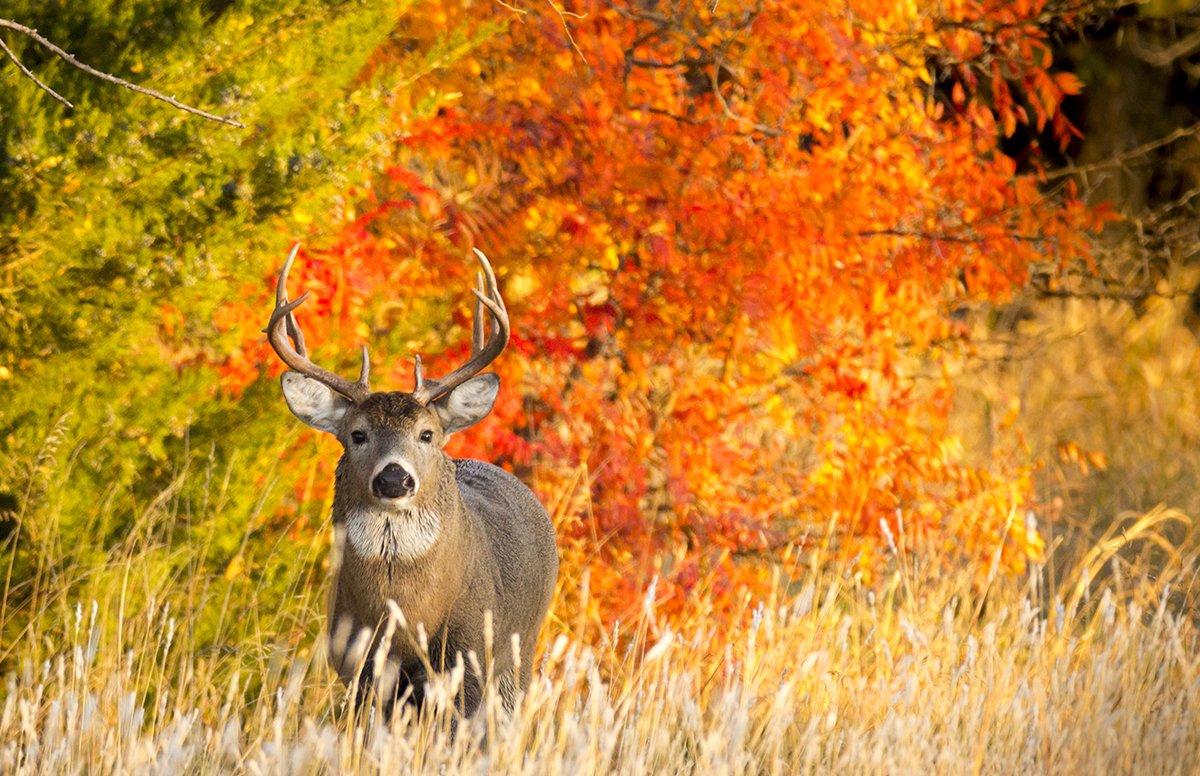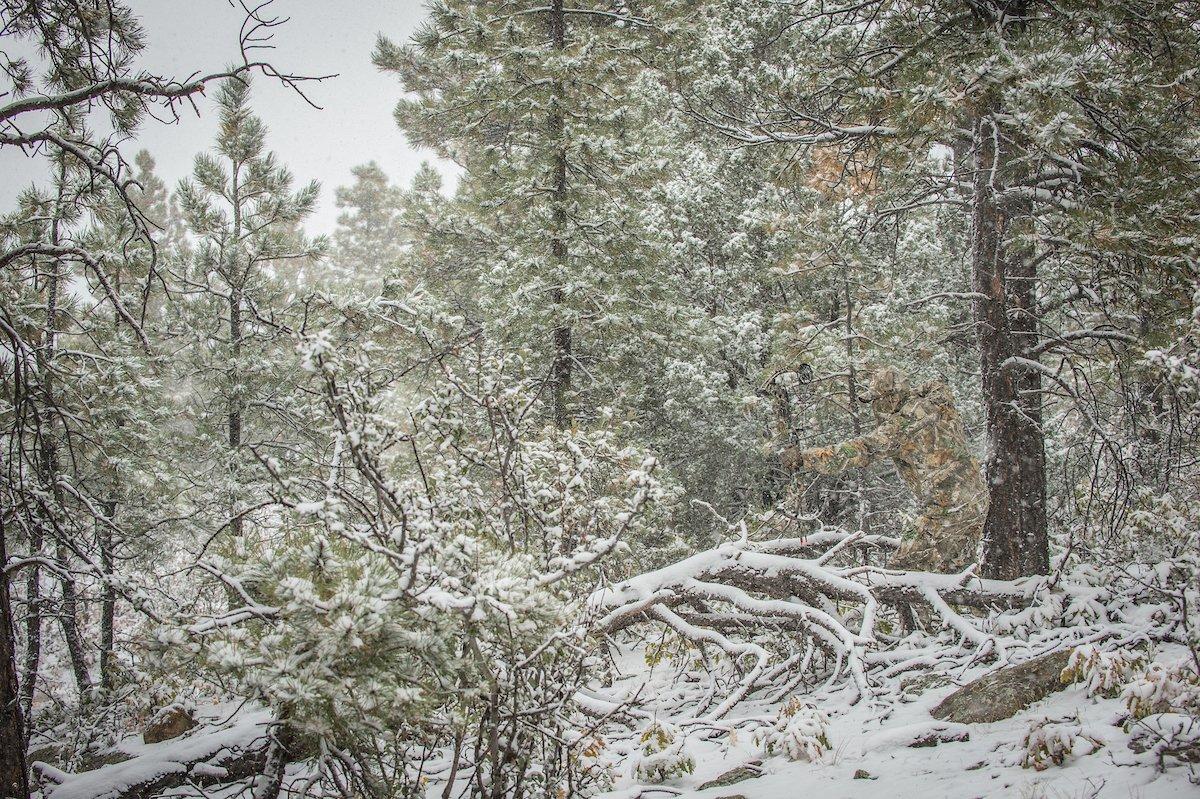Do You Understand Everything That Goes Into Concealment?
Out of place. That's how I felt. Not only was I physically uncomfortable I was extremely self-conscious about my appearance. After all, I was only 16, still a boy in most ways, and had never been in this situation before. How was I supposed to know this was going to happen? Now what do I do?
It was November 2, and the bucks on our western Illinois farm were in prime form. You could feel the testosterone hanging in the air, picture the bristled hair on the back of a swollen neck, and hear the throaty grunts echoing through hardwood bottoms and across freshly picked cornfields. It had snowed the night before — it never snows this early in Illinois. And after a Saturday morning film session of last night's season-ending football game, I was heading out to a hardwood ridge to try my hand at rattling. I was itching to hunt in these rare, yet perfect, rutting conditions. I donned my family's only pair of snow-camo overalls, normally reserved for January coyote hunting, and headed out with my bow. Typically, my brother and I would be fighting over who got to wear the sweet snow-camo versus being stuck with the old tan Carhartts. Today, though, I pulled them on without a fight.
I could already picture my setup. There I was, perfectly blending into a snow-covered oak at the head of my favorite hardwood ridge. I'd grab the attention of a cruising buck with rattling and grunts, and then watched him approach from my hidden perch, sending an arrow into his wheelhouse as he passed by. He'd never know what hit him.
That's when it started getting warmer. That's when the constant tap...tap...tap...on the oak leaves around me spelled out the obvious — the snow was melting. That's when the woods around me slowly crawled out of its hiding place from underneath the snow to reveal an extraordinary array of oranges, reds and the deep, dark, brown of sopping wet oak and hickory bark. And there I was, perched in the fork of a giant white oak a mere 12 feet off the ground, wearing bright-white snow camo.
I just froze, wishing I could disappear, hoping I wouldn't be noticed. I stuck out, as my dad would say, "like a turd in a punch bowl." How he ever knew what that looks like, I don't want to know. But you get the idea.
I waited a half hour before I broke the monotonous dripping with another series of rattling, then hung up the antlers and picked up my bow. I had yet to see anything, when I slowly turned my head to scan the woods to the West. To my surprise, I looked straight into the eyes of a monster, a huge typical staring me in the face from 80 yards. He was stiff-necked and alert. How long had he been there? One, two, 10 minutes? Was he looking past me, or just confused as to why anyone in their right mind would wear white camo on a hardwood ridge in November? His deafening snort and white flag confirmed my worst nightmare — I'd been pegged by the buck of a lifetime.
To this day, the image of that buck is burned into my mind, and with it, a priceless lesson: in hunting, camouflage can make or break you.
Since then, I've gone on to study art in college and graduated into a career in graphic design. You see, that camo pattern you don as you head out is not just a random assortment of sticks and leaves. It's a work of art. And for every hour you spend wearing it in the woods, it took hundreds of hours of planning, developing and field testing.
The same artistic principle of color, contrast, depth and shape that made DaVinci a legend also work to hide you in a duck blind, deer stand and turkey setup. You'll be amazed at how much creativity, research and ingenuity go into executing effective camo patterns.
Color
Color is the first and foremost factor in camouflage. Throughout most of the U.S., the color changes with the seasons, and it's important for your camo to keep up with this trend. While it's true that deer don't perceive color well (we'll address this in a later article), try turkey or duck hunting in a blaze orange vest and you'll soon see what I'm talking about.
During World War II and after, U.S. military vehicles were officially painted olive drab, while others were painted in local shops with whatever neutral colors were available. We soon realized, however, that adding more colors to camo was much more effective, and in 1975, patterns that called for four colors were introduced for general use on all military vehicles. We also discovered that by simply changing one or two of the four colors in a pattern, our forces could disappear into nearly any geographic or climate condition in the world. These discoveries were a major milestone in the development of modern camo, and the benefits of color variety still produce results today.
You probably remember the old acronym ROY G BIV that represents the full spectrum of color: red, orange, yellow, green, blue, indigo and violet. Different wavelengths of light are seen as different colors. But the study of color goes further than your local Sherwin Williams. Each color has three characteristics that determine how it is seen by our eyes, and by those of game we hunt. These are: hue, saturation and brightness.
Hue
When we describe a color, we are mainly referring to the color's hue. The hue is what makes a gobbler's head red, your engine oil black, and you scratch your head when your wife wants to paint the bathroom yellow. It simply refers to the wavelength of color an object reflects. That gobbler's head reflects the red wavelength, black doesn't reflect any wavelength (it absorbs them all), and well, who knows what that bathroom will reflect.
The different hues in your camo pattern are what allow you to blend into various surroundings at different times of year. A hardwood ridge in October needs a pattern like Realtree EDGE to match the orange and brown hues of turning oak leaves. A pattern like MAX-1 XT, however, best matches the neutral green and olive hues of sage, rocks and the weathered terrain of a New Mexico mule deer hunt.
So how does Realtree select its camo hues? The experts rely on experience and common sense. Photos and field samples are helpful resources, but an innate knowledge of hunting, terrain and weather conditions is much more important. Great artists "know" which colors will work and they push themselves until they succeed on canvas. Similarly, a great camo artist draws on a team of experts — many lifetimes of experience afield — to select the best possible color scheme for a great pattern. He pushes himself through revisions, field tests and more revisions until he's succeeded in the field. This refining process may take months, but the result is always worth the effort.
It's extremely beneficial to have more than one style of camo in your arsenal. Not only do seasons change, but so do hunting strategies. One October, I watched a group of does regularly enter one of our cornfields from a neighboring property. The end rows had been already cut from the field, but most of the corn was still standing. Lacking a ground blind or a tree sufficient for a stand, I built a makeshift blind out of corn stalks just inside the standing rows and swapped my usual camo for some earthy brown duck hunting attire, similar to today's Realtree MAX-5 or Realtree Timber. The setup worked perfectly, and I filled an early season doe tag.
In production, camo patterns are limited to as many as 12 colors and as few as 6 colors, depending on the fabric and the printing process that's used. It's imperative that designers choose the absolute most effective hues available.
Saturation

In the outdoors, geography and climate have huge effects on color saturation. Dry, dusty climates in broad daylight have little saturation, while wet, overcast climates with heavy foliage are deeply saturated with color. Your camo should match accordingly. For a Montana antelope hunt during a drought, you'd be better off using a pattern such as MAX-1 XT. The lighter, more neutral earth tones of this pattern match the saturation and color of dry prairie grasses and sage. In contrast, a rainy-day late season turkey hunt in Missouri would be better suited to Realtree EDGE. It's got a great mixture of heavily saturated greens and intense shadows that replicate the foliage of springtime hardwoods.
Also, take good care of your camo to ensure that it doesn't fade too quickly. Regular wear and tear, exposure to excess sunlight, and traces of leftover bleach in your washer will remove the pigment from the fibers of your gear. This will gradually desaturate the color and greatly reduce its effectiveness in the field.
I've been employing a favorite tactic of mine for years during wet weather. Instead of wearing a heavy outer layer of rain gear, I opt to wear a thin waterproof jacket and pants under my regular hunting garb. The rain dampens my outer camouflage, making it darker as it gets wet and naturally blends into the saturated woods around me. I stay dry, and my camo becomes even more effective. An added bonus is that it reduces the noise of rain gear — not only the noise caused by your movement, but also the constant dripping of raindrops hitting your gear, which can diminish your chances of hearing that distant gobble or cruising buck's footsteps.
Brightness
Brightness? In camouflage? Yes, that's right. When used effectively, bright highlights in camo can add incredible visual effects to a pattern. Brightness refers to the intensity, or illumination, of a color. In the past, bright colors were avoided like the plague (remember the olive drab of the original military vehicles?) However, countless studies, hundreds of hours of field testing, and some good, old-fashioned ingenuity has led the Realtree team to develop patterns that employ areas of bright color and highlights. How does this visual effect work for you?
On a canvas, artists add highlights and shadows to an object to make it appear 3D. The bright, highlighted side is the area that is illuminated by a source of light, while the dull, shaded side is hidden from this light. When you look at a two-dimensional canvas with an object that's well-painted with highlights and shadows, your brain automatically takes this information and sees that object as 3D. Ever seen a painting that's so real you swear you could reach out and touch it? Well, that's what the new Realtree patterns have done for camo. Your game sees and interprets highlights and shadows the same way that humans do. Realistic leaves, sticks, and brush in your camo fools them into seeing two-demensional objects on your gear as real 3D leaves, sticks and brush. And by they time they're close enough to read the "EDGE" in your pattern, it's all over with.
Hopefully, you've realized by now that there is way more to your camouflage than you've ever realized. It took Michelangelo four years to paint the ceiling of the Sistine Chapel. Similarly, it's taken years for patterns to develop into what they are today. In looking at color, we've addressed the most obvious aspect of concealment. But we've only just begun. There are other aspects to think about, such as: contrast, shape and more.
Don't Miss: 20 Deer Hunting Lies Your Granddaddy Told You
Editor's Note: This was originally published July 6, 2009.
Are you a deer hunter wanting to learn how to accomplish your goals? Check out our stories, videos and hard-hitting how-to's on deer hunting.







